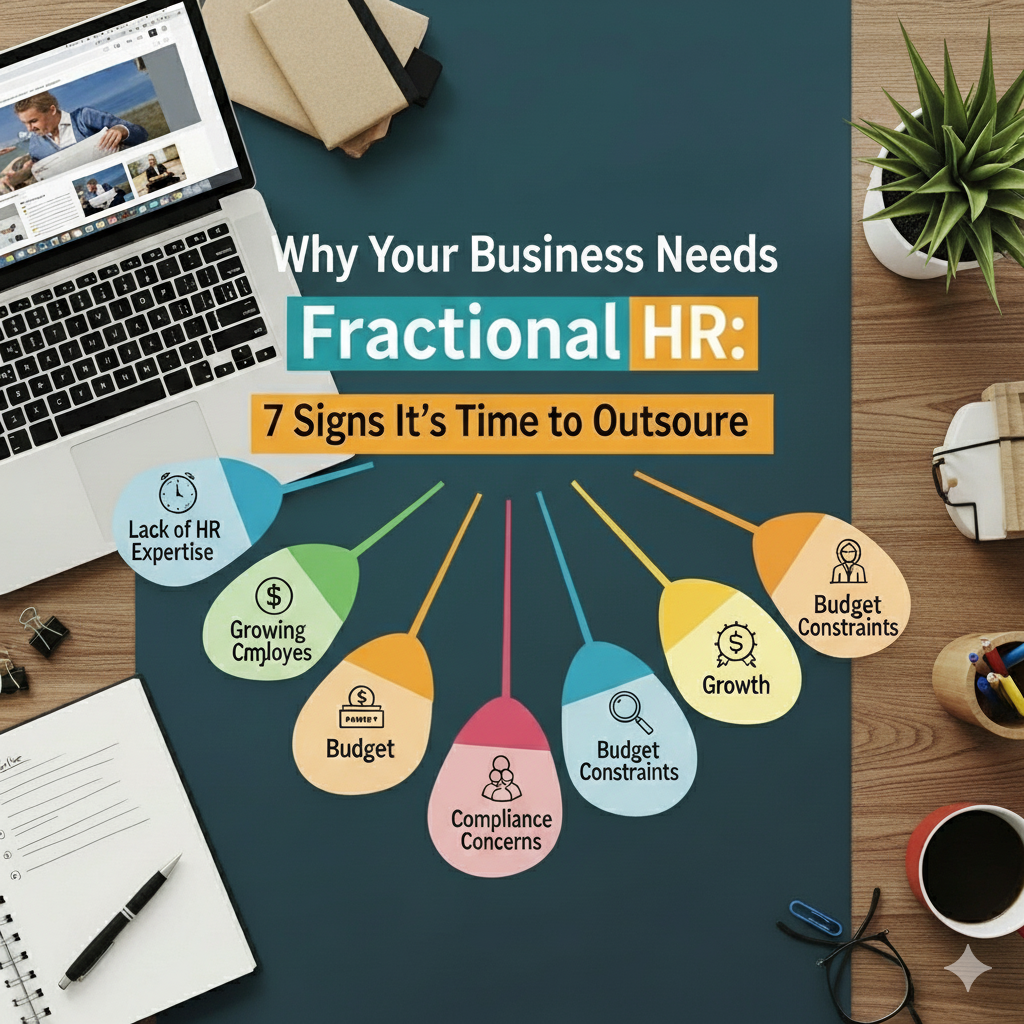
What Is Fractional HR?
A Plain-English Definition
Fractional HR is senior-level human resources support you engage part-time, on-demand, or for a defined scope—think “your HR department, but modular.” Instead of hiring a full-time HR generalist or CHRO, you plug in experienced pros for strategy, operations, or both. It’s like subscribing to the exact HR expertise you need without paying for idle hours.
How Fractional HR Engagements Work (Models & Scope)
Common models include:
- Retainer (hours per month): Ideal for ongoing HR ops (payroll audits, policy updates, employee relations).
- Project-based: Use when you need a discrete deliverable (handbooks, compensation frameworks, ATS implementation).
- Interim leadership: A fractional Head of People to steer change, build function, or coach managers while you hire.
Scope ranges from compliance and policies to recruiting, onboarding, performance frameworks, leadership coaching, culture building, and workforce planning.
Fractional HR vs. Traditional Consultants vs. PEO
- Consultants advise and hand you a slide deck; fractional HR advises and implements.
- PEOs co-employ your staff and handle payroll/benefits; fractional HR keeps you as the employer of record while building your internal capability.
- In-house hires are great—when you have the volume and budget. Before that point, fractional HR fills the gap without overhiring.
Quick Benefits Snapshot
Cost Efficiency Without Compromise
Pay only for what you use. You access senior expertise for a fraction of the full-time cost, avoiding salary, bonuses, and overhead while still getting enterprise-grade HR.
Speed, Flexibility, and Senior-Level Expertise
Scale support up or down as needs change. When deadlines loom (policy launch, hiring spike, audit), fractional HR adds bandwidth instantly—no long ramp-up.
Scalability Through Growth and Change
Whether you’re doubling headcount or entering new markets, fractional HR sets the right structures—job architectures, comp bands, leveling guides—so people operations scale as fast as revenue.
7 Signs It’s Time to Outsource HR
Sign 1 — Rapid Growth Is Outpacing Your People Processes
Typical Symptoms
- Offers sent via email drafts; no standardized templates.
- Onboarding varies wildly by manager.
- Policies written years ago, not aligned to current org.
- HR fires to put out every week.
What Fractional HR Delivers
A scalable foundation: hiring workflows, structured onboarding checklists, a living handbook, and consistent manager playbooks. That means fewer errors, faster time-to-productivity, and a better first impression for new hires.
Sign 2 — Compliance Gaps and Rising Risk Exposure
Typical Symptoms
- Unclear classification of contractors vs. employees.
- Overtime rules? Vaguely remembered.
- Recordkeeping spread across spreadsheets.
- Anxiety before every audit or legal request.
What Fractional HR Delivers
Risk mapping, policy updates, audit-ready documentation, and training. You get clarity on classifications, leave, termination processes, and regulatory requirements—reducing fines and legal exposure.
Sign 3 — High Turnover or Low Engagement
Typical Symptoms
- Exit interviews reveal manager issues, but nothing changes.
- Engagement scores flatline or dip.
- High performers leave quietly; replacements take months.
What Fractional HR Delivers
Root-cause analysis and interventions: manager training, career paths, feedback cadences, recognition programs, and calibrated compensation. Expect improved retention, clearer growth paths, and a healthier culture.
Sign 4 — HR Overload: Founder or Finance Is Doing HR at Night
Typical Symptoms
- Payroll closed at midnight by a non-HR person.
- Ad hoc offer letters copied from the internet.
- HR questions pile up because “someone will answer later.”
What Fractional HR Delivers
Triage and structure. A fractional partner takes over the recurring tasks (employee relations, documentation, compliance calendars) and builds automations so HR no longer consumes nights and weekends.
Sign 5 — Hiring Is Slow, Costly, or Off-Target
Typical Symptoms
- Time-to-fill exceeds 45–60 days for common roles.
- Interview panels ask inconsistent questions.
- Offers get rejected due to process friction.
What Fractional HR Delivers
Talent acquisition systems that just work: tightly written job scorecards, structured interviews, calibrated comp, candidate comms that build brand, and ATS hygiene. Outcome: shorter hiring cycles, fewer mis-hires.
Sign 6 — Manager Capability Gaps and Culture Drift
Typical Symptoms
- Managers promoted from IC roles without training.
- Performance reviews feel like box-ticking.
- Values on the wall, but not in behaviors.
What Fractional HR Delivers
Manager enablement: coaching, performance frameworks, escalation paths, and a culture toolkit that translates values into decisions (hiring, feedback, promotions). Culture becomes a daily operating system.
Sign 7 — Budget Constraints but Complex HR Needs
Typical Symptoms
- Not enough workload for a full-time HR leader—but too much risk to ignore.
- You need both strategic and tactical support.
- Seasonal spikes (hiring waves, expansion) overload the team.
What Fractional HR Delivers
A blended model: a fractional Head of People sets direction, while a fractional generalist or recruiter executes. You get strategic clarity and operational horsepower for less than a single senior salary.
Risks of Not Having Professional HR Support
Legal and Financial Penalties
Misclassification, unpaid overtime, or mishandled terminations can trigger fines, back pay, or lawsuits. The “we’ll figure it out later” approach is often the most expensive HR strategy.
Hidden Costs of Turnover and Poor Onboarding
Replacing an employee can cost from a fraction to multiple times their salary when you add lost productivity, hiring time, and training. Sloppy onboarding prolongs ramp time and drives early attrition.
Culture Erosion and Productivity Drag
Inconsistent policies and ad hoc management create perceived unfairness. That erodes trust, spikes conflict, and distracts teams—costing output long before anyone notices.
Data Security and HRIS Pitfalls
Spreadsheets with personal data floating around inboxes? That’s a data privacy risk. Without proper HRIS configuration, you risk inaccuracies in pay, leave, and performance records.
Employer Brand Damage
Bad candidate experiences travel fast. So do ex-employee stories. Without a consistent talent process, you unintentionally push away future hires and sour partnerships.
The Long-Term ROI of Fractional HR
Direct Cost Savings vs. In-House Headcount
A full-time HR leader plus generalist can cost six figures in salary and benefits, even before tools. Fractional HR gives you comparable expertise precisely when needed—no underutilized capacity.
Efficiency Gains: Time-to-Hire, Ramp Time, and Retention
Optimized pipelines and onboarding mean roles fill faster and new hires reach productivity sooner. Retention improves when managers receive coaching and growth paths are clear.
Quantifying Risk Mitigation
Avoiding one penalty or wrongful termination dispute can offset months of fractional spend. Standardized documentation and compliant processes materially reduce your downside.
Sample Scenario: SMB ROI Math
- Baseline: 60-person company, 12% voluntary turnover, average salary $55k.
- Improvements: Reduce turnover to 9% (≈2 fewer exits/year) and cut time-to-fill by 20%.
- Result: Savings from reduced backfill, agency fees, lost productivity, and faster ramp can easily outweigh a fractional retainer—while also improving morale and output.
KPI Dashboard to Track
- Time-to-fill, offer-accept rate, new-hire ramp time
- Voluntary turnover and regretted loss
- Engagement scores and manager effectiveness
- Compliance calendar adherence
- Cost-per-hire and recruiting channel ROI
How to Choose a Fractional HR Partner
Selection Criteria
- Stage-fit: Startup, scale-up, or mature—look for similar past clients.
- Breadth & depth: Can they cover strategy and day-to-day ops?
- Change management: Evidence they can drive adoption, not just write docs.
- Data fluency: Comfortable with HRIS, analytics, and reporting.
- Cultural alignment: Communication style that fits your leadership team.
Questions to Ask Before You Sign
- What does success look like in 30/60/90 days?
- Who’s on my team, and how is knowledge retained?
- How will you transfer capability to us (so we’re not dependent)?
- What tools and frameworks do you bring?
- How do you measure ROI and share progress?
Pricing Models and Expectations
Expect retainers for ongoing ops and fixed-fee projects for discrete deliverables. Great partners are transparent on hours, outcomes, and change requests—no mystery invoices.
90-Day Implementation Roadmap
Days 0–30: Discovery & Stabilize the Basics
- HR audit: policies, contracts, payroll, benefits, org structure
- Risk register with priority fixes
- Quick wins: onboarding checklists, compliant templates, employee relations triage
- Set the KPI baseline (turnover, time-to-fill, engagement inputs)
Days 31–60: Build Repeatable People Ops
- Implement or optimize HRIS and ATS
- Standardize hiring (scorecards, interview kits, training)
- Launch performance & feedback rhythms (1:1s, expectations, growth plans)
- Manager coaching on essentials: feedback, documentation, escalation
Days 61–90: Optimize, Automate, and Coach
- Automate recurring tasks (offer generation, onboarding workflows)
- Roll out compensation bands and leveling guides
- Launch engagement pulse and action plans
- Executive readout: progress vs. baseline and the next quarter’s roadmap
Common Objections (and Grounded Answers)
- “We’re too small.” You’re precisely the size where one mistake is costly. Fractional HR is a right-size solution.
- “We can just Google templates.” Templates don’t implement themselves or fit your context. Fractional HR adapts and embeds them into habits.
- “We’ll hire HR later.” You still need compliant processes, documentation, and manager support now. Fractional HR builds the runway and hands you the controls.
- “It’s expensive.” Compared to lawsuits, turnover, or mis-hires? The math typically favors fractional support within a quarter.
Recommended Toolstack for Fractional HR Success
- HRIS & Payroll: Platforms that centralize employee data, time off, and pay.
- ATS: Structured pipelines, interview kits, and reporting to cut time-to-fill.
- Performance & Feedback: Lightweight tools for goals, check-ins, and reviews.
- Engagement & Surveys: Pulse insights with action planning.
- Knowledge Base: A living handbook for policies, perks, and processes.
- Compliance Calendar: Automated reminders for filings, trainings, and audits.
(Your fractional partner will recommend stage-appropriate options and implement them without overengineering.)
Conclusion
Fractional HR gives you the best parts of a seasoned HR team—without the full-time price tag. If growth is messy, compliance feels risky, hiring drags, or managers need coaching, it’s time to bring in flexible professionals who can design systems, train leaders, and keep you audit-ready. The payoff is compounding: safer operations, better hires, stronger culture, and real savings that show up on the P&L.
FAQs
1) What’s the difference between fractional HR and an HR consultant?
Consultants advise; fractional HR advises and operates. You get strategy plus hands-on execution, often with a dedicated team acting as your part-time HR department.
2) How many hours do we need each month?
Most small companies start with a modest retainer (e.g., 20–40 hours/month) for steady-state ops, plus short sprints for projects like handbooks, compensation bands, or performance frameworks.
3) Can fractional HR help if we already have an HR coordinator?
Absolutely. A fractional leader can mentor coordinators, set direction, and handle the complex work (employee relations, comp design), while the coordinator manages day-to-day tasks.
4) What results should we expect in the first 90 days?
Stabilized compliance, standardized hiring and onboarding, clearer manager practices, and a KPI baseline. You should also see fewer fires and faster, more confident decision-making.
5) When should we transition to a full-time HR hire?
When your recurring workload consistently exceeds part-time capacity and you need immediate in-house responsiveness. A good fractional partner will help define the role and even recruit for it.
Struggling with compliance gaps, high turnover, or chaotic hiring? You don’t need to do it alone. Our Fractional HR experts will step in, fix your biggest pain points, and build people systems that actually scale with your business.
✨ Start with a free HR Health Check—get your custom roadmap today.

Leave a Reply